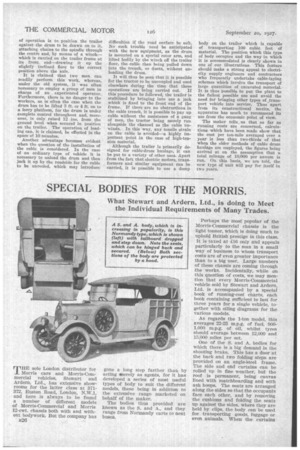FACILITATING CABLE DRUM HAULAGE.
Page 43

Page 44

If you've noticed an error in this article please click here to report it so we can fix it.
An Interesting Type of Trailer which Simplifies the Tasks of Loading and Unloading Drums of High-voltage Cable.
THE awkward character of heavy drums of high-voltage cable occasions certain difficulties to those concerns which have to arrange for the transport or haulage of such loads. Special types of vehicle, generally of the tractor-lorry class, hace been built for the work, and by reason of their low loading-line have• undoubtedly facilitated the operations of loading and unloading. The type of drum which is being largely used nowadays is much heavier than that which had to be dealt with a few years ago, when it was unusual for a drum to exceed a gross weight of 5 tons. To-day, however, such drums have an average weight of between 6 tons and 8 tons, and this increase has introduced further difficulties in connection with their handling and transport.
One of the most recent contributions to the problem of aiding the haulage of cable drums is to be found in the Feast cable drum manipulator, which is made by its patentees, Southend-on-Sea Automobiles, Ltd., 461-465, London Road, Southend-on-Sea, Essex. The illustra
tions which we reproduce on this page will serve to give a good idea of the general lines on which the apparatus is constructed, and it will be seen that t consists in the main of a low-bodied trailer, which is designed to be drawn by an industrial tractor.
The trailer is built up of channel-iron of substantial dimensions, with a heavy cranked, axle of forged steel as an in
tegral part of the main frame, this being designed to carry the full weight of the drum. The design is particularly robust and possesses an unusually high factor of safety, whilst it embodies features which have been specifically introducedto enable the trailer to undertake efficiently the work it is intended to perform.
The outstanding advantages of the Feast apparatus can perhaps best be illustrated by comparing the older method of cable drum manipulation with the new procedure. The method of operation is to position the trailer against the drum to be drawn on to it, attaching chains to the spindle through the centre and, by means of a winch— which is carried on the trailer frame at its front. end—drawing it up the slightly inclined floor to the correct position above the axle.
It is claimed that two men can readily perform this work, whereas, under the old system, it was often necessary to employ a group of men in charge of an experienced operator. Furthermore, there is no danger to the workers, as is often the case when the drum has to be lifted 3 ft. or 4 ft. on to a lorry platform, for the drum is under complete control throughout and, moreover, is only raised 12 ins, from the ground level when secured in position on the trailer. The operation of loading can, it is claimed, be effected in the space of 10 minutes.
Another advantage becomes evident when the question of the installation of the cable is considered. In the case of an ordinary type of vehicle it is necessary to unload the drum and then jack it up by the roadside for the cable to be unreeled, which may introduce
difficulties if the road surface be soft. No such trouble need be anticipated with the new equipment, as the drum is mounted on a special rotor arm, and lifted bodily by the winch off the trailer floor, the cable then being pulled down into the trench, or ducts, without unloading the drum.
It will thus be seen that it is possible for the tractor to be uncoupled and used elsewhere during the time that these operations are being carried out. If this procedure be followed, the trailer is stabilized by bringing into use a jack which is fixed to the front end of the frame. If there are no obstructions in the cable trench, it is possible to pay up cable without the assistance of a gang of men, the tractor being merely run alongside the channel as the cable 'unwinds. In this way, any tensile strain on the cable is avoided—a highly important point in the case of high-tension material.
Although the trailer is primarily designed for cable-drum haulage, it can be put to a variety of other uses. Apart from the fact that electric motors, transformers and similar equipment can be carried, it is possible to use a dump body on the trailer which is capable of transporting 100 cubic 'feet of material. The position which this type of body occupies and the way in which it is accommodated is clearly shown in one of our illustrations. This feature should make a strong appeal to electricity supply engineers and contractors who frequently undertake cable-laying schemes which involve the transport of large quantities of excavated material.It is thus possible to put the plant to the fullest possible use and avoid the need for bringing other types of _transport vehicle into service. Thus apart from its constructional merits, the apparatus has much to recommend its use from the economic point of view.
The maker tells us that so far as running costs are concerned, calculations which have been made show that the cost per ton-mile averaged over a year is less than two-thirds of that when the older methods of cable drum haulage are employed, the figures being arrived at on the assumption that a total mileage of 10,000 per annum is run. On this basis, we are told, the new type of unit will pay for itself in two years.




































































































